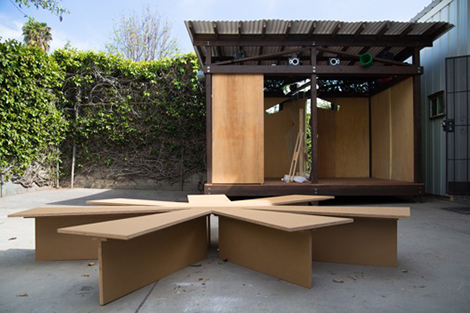The Los Angeles Museum of Art is a DIY structure approximately 100 square-feet situated in the corner of a paved yard in Eagle Rock. Founded and run by the artist Alice Könitz, LAMOA continues in the long line of LA-based artist-run spaces that crop up regularly but particularly during economic downturns when the market shrinks, causing artists to look for alternative ways of exhibiting their work.
At LAMOA, Renee Petropoulos’ “Proposal for a Pavilion” presents several interwoven works: a mirrored sculpture, Bouquet (Flower Girl) Between Libya, the United States and Scotland, a sound collaboration with the composer Greg Lenczycki, customized seating, and a blog with lists of associated words and photos (all works 2014). Together they function as a multilayered indexical tool centered on the specific historical event known as the Lockerbie bombing, citing art histories ranging from conceptual (Dan Graham) to theatrical (Ilya and Emilia Kabakov).
For the artist, the Lockerbie incident catalyzed the moment when air travel changed, becoming dangerous and political. Those who don’t know can learn via text culled from documentation referencing the event how a terrorist bomb caused the jet crash of Pan Am Flight 103 over Lockerbie, Scotland on December 21, 1988, killing 270 people. Abdelbaset al-Megrahi, a Libyan intelligence officer, was jailed in 2001 after long and complicated investigations. In 2009, he was released after being diagnosed with prostate cancer and he died in 2012, the only person ever convicted of the bombing. In 2003, Gaddafi accepted responsibility and paid compensation, although he maintained never having ordered the attack. Numerous conspiracy theories remain regarding the responsibility for the explosion.
A flattened and mirrored silhouette figure based on Varvara Stepanova’s agitprop figure for the revolutionary play, The Death of Tarelkin, staged in 1899, is propped up in the center of Petropoulos’ pavilion, reflecting viewers as they circle her. Holding a bouquet with flowers of the three countries (visible in contour from the front and photographically from behind—pomegranate for Libya, red rose for the U.S., and thistle for Ireland), this sculpture fuses and contests the notion of abstract relationships between nation states that communicate through diplomatic relations. The work is accompanied by a five-part, 75-minute sound recording made from the three countries’ national anthems. In front of LAMOA, an asterisk-shaped wooden bench encourages viewers to congregate, echoing the precise positioning of treaty tables or for diplomatic seating. Together these sounds, objects and images add up to a contradictory mix: innocuous and soothing in appearance yet ominous once their sources are revealed. The same double take occurs with the blog: a seemingly arbitrary list of words and snapshots turns into forensic evidence when the viewer learns that they were drawn from the incident.
The register Petropoulos works from in her pavilion is indirect. Building by inference, she explores how identity is projected onto individuals when absorbed into a larger body politic while interrogating the symbolic modes deployed in this process.



